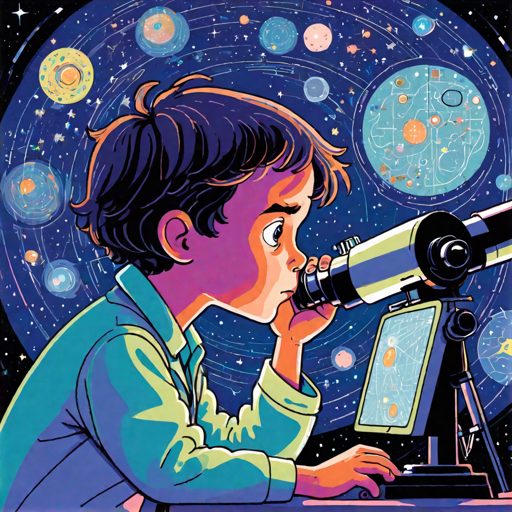
Scientists Discover One of the Universe’s Oldest Stars Next Door
Recommended for Middle Grades
Whispers of the Universe’s Genesis Found in a Neighboring Galaxy
The cosmos, that boundless ocean of shimmering starlight, holds mysteries that ignite the human soul. Yet, what if the answers to our cosmic origins lie hidden within a seemingly unremarkable star, a beacon from the universe’s earliest chapter?
Scientists, those stargazing explorers of the infinite, stumbled upon a wonder – a cosmic relic residing in the Large Magellanic Cloud (LMC). A swirling companion to our Milky Way, the LMC shelters this ancient star.
Within its primal light lies a story that echoes from an era long before the birth of our own sun, a whisper from the universe’s fiery dawn.
Decoding the Stellar Fossil
“Maya, imagine the cosmos as a vast library,” Dr. Tanaka mused, the twinkle in his eye reflecting the starlight on his face. “We study the books, the galaxies and stars, trying to decipher the epic tale of creation… and this star? It’s a page torn from the very first chapter, pristine and untouched by time’s relentless edits.”
“The stars that ignited after the Big Bang were cosmic behemoths,” he continued, his voice laced with reverence. “Their colossal hearts were cosmic forges, birthing the elements that are the very essence of life itself.”
But those titans were fleeting, their fiery lives ending in spectacular explosions. This star, Maya, it carries the echoes of those grand beginnings, a relic from the epoch when those giants scattered their essence across the void.”
“The star’s outer layers act as a cosmic vault,” he explained. “They hold the chemical fingerprints of its birth cloud, etched in starlight. In essence, we are deciphering the recipe used by those first, titanic stars to build the foundations of all that exists.”
Hunting for a Ghost in the Starlight
Dr. Tanaka’s eyes gleamed with the thrill of the hunt. “The first behemoths blazed with the pristine light of hydrogen and helium, Maya. The heart of our sun, countless younger stars…they bear the mark of a more complex lineage.”
“Within their light, we find the signatures of carbon, iron, the cosmic building blocks forged in the dying breaths of those early giants.”
“But the most ancient stars? They are almost spectral in their simplicity. To find them, we search not for what is there, but for what is missing. That lack of complexity…it’s a beacon pointing us towards the dawn of time.”
A Cosmic Surprise in Our Galactic Backyard
“But what makes this star truly exceptional, Maya, is where we found it,” Dr. Tanaka’s voice held the thrill of the unexpected. “The Milky Way…it’s a grand old spiral, a swirling metropolis of countless stars. The ones within our cosmic neighborhood hold a jumbled history, eons of stellar lives and deaths blending their chemical legacies.”
“The LMC, though…it’s smaller, a more recent addition to our cosmic dance. Until not so long ago, in the cosmic timescale, it was a solitary island. You can learn more about the Large Magellanic Cloud on NASA’s website. Its most ancient stars, like LMC-119, preserve a snapshot of its unique beginnings, a time before its path tangled with our own.”
“LMC-119,” he declared, “is the most pristine cosmic fossil we’ve discovered beyond the bounds of the Milky Way. It whispers of a universe less uniform than we imagined, where the first breaths of galaxies were as diverse as the cosmos is today.”
The Legacy of Stars
As Maya gazed out at the night sky, it was no longer simply a collection of twinkling lights. Each star became an ember, part of the grand cosmic bonfire that kindled the universe itself.
Some, bright and young, were born in vast stellar nurseries. Others, dimmer and ancient, carried the secrets of the cosmos’s tumultuous infancy. And somewhere, in the heart of a neighboring galaxy, LMC -119, a relic of unimaginable age, patiently waited for its story to be deciphered.
The universe was no longer static but an epic unfolding across time and space. We are both spectators and children of this grand spectacle, forever bound to the stars by the very stardust that courses through our veins.
Watch a video
Find out what makes stars what they are, and take a tour of some of the most extreme stars in space!
Curious Times is a leading newspaper and website for kids. We publish daily global news aligned to your learning levels (also as per NEP 2020): Foundational, Preparatory (Primary), Middle and Senior. So, check out the News tab for this. We bring kids’ favourite Curious Times Weekly newspaper every weekend with top news, feature stories and kids’ contributions.
Curious Times News Program for Schools for FREE. Over 5,000 schools and teachers from all over the world have joined our programme so that students and teachers can get FREE Educative Newspaper. Here, kids can take part in world events and win prizes and certificates for free through their schools.
The following social media platforms allow you to communicate with us: Instagram.
0 (Please login to give a Curious Clap to your friend.)
